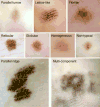Educational and practice gaps in the management of volar melanocytic lesions
- PMID: 29178552
- PMCID: PMC5967984
- DOI: 10.1111/jdv.14712
Educational and practice gaps in the management of volar melanocytic lesions
Abstract
Background: The benign and malignant patterns of acral melanocytic naevi (AMN) and acral melanomas (AM) have been defined in a series of retrospective studies. A three-step algorithm was developed to determine when to biopsy acral melanocytic lesions. This algorithm has only been applied to a Japanese population.
Objectives: Our study aimed to review the current management strategy of acral melanocytic lesions and to investigate the utility of the three-step algorithm in a predominately Caucasian cohort.
Methods: A retrospective search of the pathology and image databases at Mayo Clinic was performed between the years 2006 and 2016. Only cases located on a volar surface with dermoscopic images were included. Two dermatologists reviewed all dermoscopic images and assigned a global dermoscopic pattern. Clinical and follow-up data were gathered by chart review. All lesions with known diameter and pathological diagnosis were used for the three-step algorithm.
Results: Regular fibrillar and ridge patterns were more likely to be biopsied (P = 0.01). The majority of AMN (58.1%) and AM (60%) biopsied were due to physician-deemed concerning dermoscopic patterns. 39.2% of these cases were parallel furrow, lattice-like or regular fibrillar. When patients were asked to follow-up within a 3- to 6-month period, only 16.7% of the patients returned within that interval. The three-step algorithm would have correctly identified four of five AM for biopsy, missing a 6 mm, multicomponent, invasive melanoma.
Conclusion: We found one major educational gap in the recognition of low-risk lesions with high rates of biopsy of the fibrillary pattern. Recognizing low-risk dermoscopic patterns could reduce the rate of biopsy of AMN by 23.3%. We identified two major practice gaps, poor patient compliance with follow-up and the potential insensitivity of the three-step algorithm to small multicomponent acral melanocytic lesions.
© 2017 European Academy of Dermatology and Venereology.
Conflict of interest statement
None of the authors have any conflicts of interest to disclose.
Figures



Similar articles
-
Age and Anatomical Location-Related Dermoscopic Patterns of 210 Acral Melanocytic Nevi in a Turkish Population.J Cutan Med Surg. 2017 Sep/Oct;21(5):388-394. doi: 10.1177/1203475417712496. Epub 2017 Jun 1. J Cutan Med Surg. 2017. PMID: 28565919
-
[Dermoscopic pattern analysis of acral melanocytic nevi].Przegl Lek. 2013;70(11):911-5. Przegl Lek. 2013. PMID: 24697028 Polish.
-
Clinical and Histopathologic Characteristics of Melanocytic Lesions on the Volar Skin Without Typical Dermoscopic Patterns.JAMA Dermatol. 2019 May 1;155(5):578-584. doi: 10.1001/jamadermatol.2018.5926. JAMA Dermatol. 2019. PMID: 30865233 Free PMC article.
-
Key points in dermoscopic differentiation between early acral melanoma and acral nevus.J Dermatol. 2011 Jan;38(1):25-34. doi: 10.1111/j.1346-8138.2010.01174.x. J Dermatol. 2011. PMID: 21175752 Review.
-
Role of In Vivo Reflectance Confocal Microscopy in the Analysis of Melanocytic Lesions.Acta Dermatovenerol Croat. 2018 Apr;26(1):64-67. Acta Dermatovenerol Croat. 2018. PMID: 29782304 Review.
Cited by
-
Pattern Analysis of Benign and Malignant Atypical Melanocytic Skin Lesions of Palms and Soles: Variations of Dermoscopic Features According to Anatomic Site and Personal Experience.Life (Basel). 2024 May 22;14(6):659. doi: 10.3390/life14060659. Life (Basel). 2024. PMID: 38929643 Free PMC article.
-
In Vivo Reflectance Confocal Microscopy Applied to Acral Melanocytic Lesions: A Systematic Review of the Literature.Diagnostics (Basel). 2024 Sep 25;14(19):2134. doi: 10.3390/diagnostics14192134. Diagnostics (Basel). 2024. PMID: 39410538 Free PMC article. Review.
-
Acral lentiginous melanoma in situ: dermoscopic features and management strategy.Sci Rep. 2020 Nov 25;10(1):20503. doi: 10.1038/s41598-020-77425-z. Sci Rep. 2020. PMID: 33239715 Free PMC article.
-
A European Multicentric Investigation of Atypical Melanocytic Skin Lesions of Palms and Soles: The iDScore-PalmoPlantar Database.Diagnostics (Basel). 2024 Feb 20;14(5):460. doi: 10.3390/diagnostics14050460. Diagnostics (Basel). 2024. PMID: 38472933 Free PMC article.
-
Ancillary techniques to improve dermoscopy specificity for skin cancer detection.Clin Exp Dermatol. 2023 Mar 1;48(3):167-174. doi: 10.1093/ced/llac065. Clin Exp Dermatol. 2023. PMID: 36763719 Free PMC article.
References
-
- Altamura D, Altobelli E, Micantonio T, Piccolo D, Fargnoli MC, Peris K. Dermoscopic patterns of acral melanocytic nevi and melanomas in a white population in central Italy. Archives of dermatology. 2006;142(9):1123–8. - PubMed
-
- Miyazaki A, Saida T, Koga H, Oguchi S, Suzuki T, Tsuchida T. Anatomical and histopathological correlates of the dermoscopic patterns seen in melanocytic nevi on the sole: a retrospective study. J Am Acad Dermatol. 2005;53(2):230–6. - PubMed
-
- Saida T, Miyazaki A, Oguchi S, Ishihara Y, Yamazaki Y, Murase S, et al. Significance of dermoscopic patterns in detecting malignant melanoma on acral volar skin: results of a multicenter study in Japan. Arch Dermatol. 2004;140(10):1233–8. - PubMed
-
- Saida T, Oguchi S, Miyazaki A. Dermoscopy for acral pigmented skin lesions. Clin Dermatol. 2002;20(3):279–85. - PubMed
MeSH terms
Grants and funding
LinkOut - more resources
Full Text Sources
Other Literature Sources
Medical
Miscellaneous

